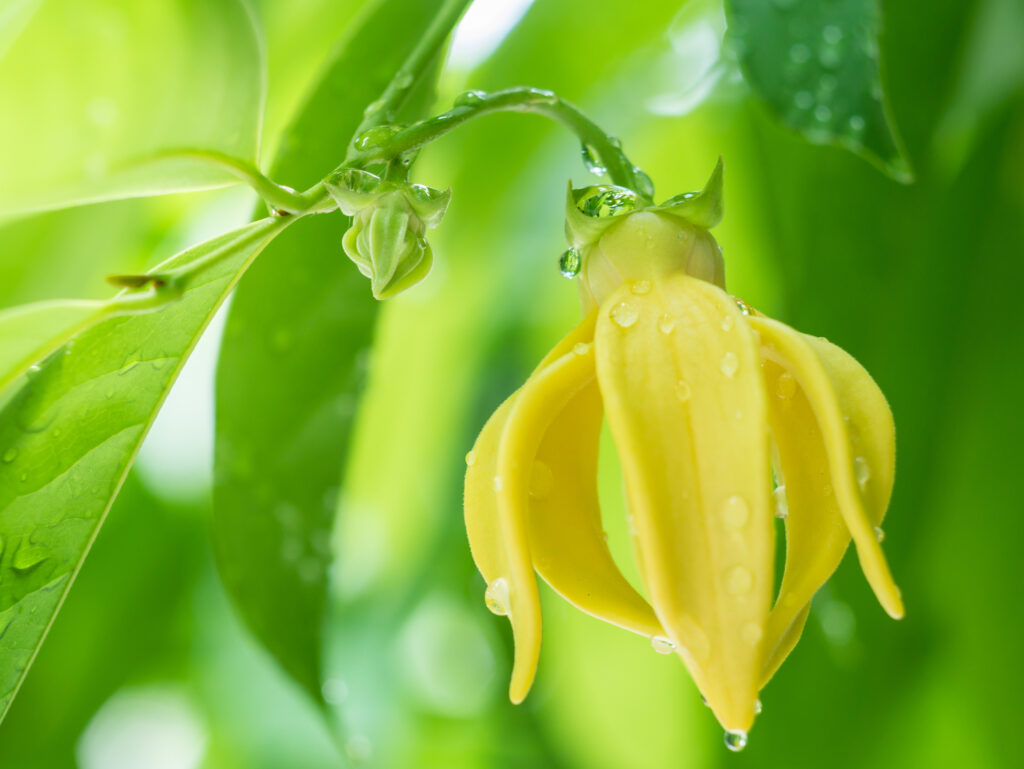Ylang ylang – Essential Oil
Ylang ylang (Canaga odorata var. genuina)
The name means ‘flower of flowers’, and ylang ylang blooms were often scattered on the beds of those who were just married as the flowers are believed to have aphrodisiac qualities.
In Victorian times, an oil called Macassar oil was used as a treatment for the scalp and was thought to encourage hair growth. Ylang ylang was an ingredient in this oil. It can be quite overpowering on its own so it is often mixed with other oils like lavender to soften the scent.
Other uses include:
Acne / oily skin
High blood pressure
Panic attacks
Drug withdrawal
Sexual problems
Depression / nervous tension
Cautions
Do not use on children or babies under the age of 12 years old.
If used for too long a time and in too great a concentration, it can lead to headaches and nausea.
Acne / oily skin
Ylang ylang balances sebum production.
Directions for use
Compress: Add 1 to 2 drops of pure essential oil to 1 litre of warm water. Lay sterile material on the surface of the water thus attracting a film of oil onto the cloth. Apply the material onto the affected area and leave for 10 minutes. Repeat daily.
Facial Massage: Mix 1 drop of pure essential oil to 2 teaspoons of almond or grape seed oil, or any other carrier oil, and rub into face.
Inhalation: Boil 1 litre of water and pour into a bowl, add up to 10 drops of pure essential oil, place a towel over your head, and allow steam to rise onto face. Do not do if the skin is very sore as the steam may ‘burn’ already painful skin.
High blood pressure
Ylang ylang treats feelings of anger and frustration.
Directions for use
Inhalation: Boil 1 litre of water and pour into a bowl, add up to 10 drops of pure essential oil, place a towel over your head, and allow steam to rise and inhale. Use once a week.
Handkerchief: Put a couple of drops of pure essential oil onto a tissue or handkerchief and inhale as and when required.
Massage: Mix 20 ml of carrier oil (sweet almond, grapeseed) to 10 drops of pure essential oil.
Oil burners: Sprinkle up to 5 drops of pure essential oil onto water and light burner.
Panic attacks
Ylang ylang has a sedative effect on the nervous system therefore calming anxiety.
Directions for use
Inhalation: Boil 1 litre of water and pour into a bowl, add up to 10 drops of pure essential oil, place a towel over your head, and allow steam to rise and inhale. Use once a week.
Handkerchief. Put a couple of drops of pure essential oil onto a tissue or handkerchief, and inhale as and when required.
Massage: Mix 20 ml of carrier oil (sweet almond, grapeseed) to 10 drops of pure essential oil.
Oil burners: Sprinkle up to 5 drops of pure essential oil onto water and light burner.
Drug withdrawal
Ylang ylang builds up feelings of self-esteem and self-worth and so eliminates fear of people and failure.
Directions for use
Massage: Mix 20 ml of carrier oil (sweet almond, grape seed) to 10 drops of pure essential oil.
Bath: Add up to 5 drops of pure essential oil to a bath of water, and lie back and relax.
Sexual problems
Ylang ylang works on an emotional level relieving anxiety, and boosting confidence.
Directions for use
Massage: Mix 20 ml of carrier oil (sweet almond, grape seed) to 10 drops of pure essential oil.
Bath: Add up to 5 drops of pure essential oil to a bath of water, lie back and relax.
Depression and nervous tension
Ylang ylang oil has antidepressant qualities.
Directions for use
Bath: Add up to 5 drops of pure essential oil to a bath of water, lie back and relax.
Handkerchief: Put a couple of drops of pure essential oil onto a tissue or handkerchief and inhale as and when required.
Massage: Mix 20 ml of carrier oil (sweet almond, grapeseed) to 10 drops of pure essential oil.
Oil Burners: Sprinkle up to 5 drops of pure essential oil onto water and light the burner.
Inhalation: Boil 1 litre of water and pour into a bowl, add up to 10 drops of pure essential oil, place a towel over your head, and allow steam to rise and inhale.
Further Information
Where grown: Ylang ylang is native to Philippines, Java, and Madagascar. The tree grows up to 19 metres high.
Parts used and method of extraction: The yellow or pink flowers of this tree are used to make the oil by steam distillation; the yellow flowers produce the best oils. The first distillation is the most expensive and of the highest quality. There are a further three grades down from the highest grade.
Colour and smell: Pale yellow. It is floral, and although it has a fragrance unique to itself, it is similar to Jasmine. It is very sweet oil indeed, and it can be a little overpowering and sickly for some people.
Active ingredients: Pinene, eugenol, methyl benzoate, geraniol, linalool, safrol, ylangol, terpenes, methyl salicilate, benzyl acetate, and a combination of formic, benzoic, acetic, salicylic, and valeric acids.
Properties: Antidepressant, aphrodisiac, sedative.
Mixes well with: Lemon and bergamot. If you find ylang ylang too sickly, these two oils will lessen the sweet smell.

